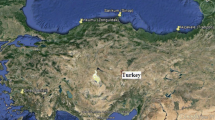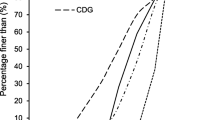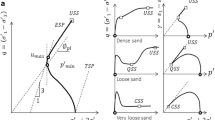Abstract
Grain shape is one of the most significant factors that influence the mechanical properties of sand material, e.g. shear strength, compactness. In this study, five groups of Fujian standard sand samples with different ranges of particle sizes were characterized respectively. The digital photos of samples on the sensitive plate have been processed by using the image recognition technology and the two-dimensional (2D) contour of each sand particle has been extracted. The geometries of the sands have been characterized based on the statistical analysis of the geometric parameters of a large number of grains. Finally, the sand grain shape is evaluated in terms of five common grain shape parameters, including the length-width ratio, flatness, roundness, practical sphericity and sphericity.
Access provided by CONRICYT-eBooks. Download conference paper PDF
Similar content being viewed by others
Keywords
1 Introduction
Sand material is commonly used in the geotechnical engineering. In the framework of conventional continuum mechanics, soil material is treated as a continuum material. However, the soil in nature is discrete. Thus, in the particle-scale perspective, the properties of individual soil particle, i.e. particle size and particle shape significant affect the behavior of soil assembly [1, 2]. To correlate the shape parameter to mechanical property of soil assembly, it is necessary to characterize the grain shape. Nevertheless, it is a difficult research problem due to three main reasons. Firstly, the shape of particle is mainly determined by environment condition, such as mother rock composition, rock weathering, handling, deposition and so on, which makes it difficult to sum up shape variation rules [3]. The second reason is that different research unities have different opinions on the description of sand shape parameters [4, 5]. So far, there is not a unified evaluation standard. The last reason is lacking efficient and accurate methods to extract a large number of sand shape parameters because of small sizes and diversity of sand material. As Fujian standard sand is widely used in practical engineering and laboratory experiments, this paper will characterize and analyze diverse grain shape parameters of this sand. The python image recognition program library named opencv (Open Source Computer Vision) is used to extract shape parameters of samples with different grain sizes from digital photos. Then five grain shape parameters are quantitatively analyzed and evaluated.
2 Description and Selection of Shape Parameters
The basic geometric parameters have been summarized in Table 1, which illustrate the diagrammatic sketch of relevant geometric dimensions [6, 7].
Image analysis and identification method were used to digitize 3D solid grain into 2D images. Five kinds of shape parameters are selected for analyzing, including length-width ratio, flatness, roundness, practical sphericity and sphericity. Table 2 lists these five concerned parameters and their corresponding formulas [7, 8].
3 Acquisition and Processing of Sample Grain Image
Five groups number one to five of Fujian standard sand were obtained by vibratory sieving. The grain size for each group corresponds to 0.85–1, 1–1.18, 1.18–1.45, 1.45–1.66 and 1.66–2 (mm) respectively. The image recognition technology allows processing a large number of grains each time, about 400 grains.
The high-quality photos of sand grains on shadowless LED flat lamp were taken by 24.3-million pixel cameras. Python and opencv are used to identify pixel point from digital images. We set a threshold value to divide the image data into two parts, black and white, called binarization processing. Then, we can get coordinates by identifying the reference ruler and converting the external contour into a polygon consisting of a set of arrays. After field segmentation, target separation and other operations, the coordinates of all grains in each photo can be extracted.
4 Assessment of Shape Parameters
Concentrated interval means the shape parameters in this range accounted for more than 95% of the total number of grains. As shown in Fig. 1, there is a common phenomenon that shape parameter values, for all the five groups, concentrate on a specific interval. Whereas, their average values do not at center of the interval, which means that they belong to the skewed distribution. The length of concentrated interval (LCI) of different shape parameters can stand for sensitivity degree to particle shapes description.
The Coefficient of variation (COV) is the ratio of variance to average value, which is frequently used to reflect dispersion degree of a set of data. Thus, the shape parameters sensibility degree can be reflected by COV. As shown in Fig. 2 the sensitivity degrees of roundness and practical sphericity are relatively lower and the length-width ratio has a high sensitivity degree to particle shapes description. As shown in Table 3, the mean of COV of the length-width ratio, flatness and sphericity are higher than those of the roundness and sphericity, which mean that their sensibility to description of particle shapes is different. Moreover, the two parameters’ extent of reaction to deviating from spheroidal particles is also worse than that of other three parameters.
5 Conclusions
According to the shape parameter analysis, two main conclusions can be drawn: (1) the five parameters obey skewed distribution. When the grain diameter ranges between [0.85 mm–1.66 mm], particle shapes close to standard ball with increase of grain diameters. In contrast, when grain diameter ranges between [1.66 mm–2 mm], the irregularity of particle shapes increases, and (2) sensibility of flatness and roundness are at intermediate level by analyzing CI length and COV. Roundness and practical sphericity have the weakest sensibility to particle shapes descriptions.
References
Jing, X.Y., Zhou, W.H., Zhu, H.X., Yin, Z.Y., Li, Y.: Analysis of soil-structural interface behavior using three-dimensional DEM simulations. Int. J. Numer. Anal. Methods Geomech. (2018)
Zhu, H., Zhou, W.H., Yin, Z.Y.: Deformation mechanism of strain localization in 2D numerical interface tests. Acta Geotech., 1–17 (2017)
Folk, R.L.: Petrology of Sedimentary Rocks. Hemphill Publishing Company, Austin (1980)
Ehrlich, R., Weinberg, B.: An exact method for characterization of grain shape. J. Sediment. Res. 40(1) (1970)
Cho, A.G., Dodds, J., Santamarina, J.C.: Particle shape effects on packing density, stiffness, and strength: natural and crushed sands. J. Geotech. Geoenviron. Eng. 132(5), 591–602 (2006)
Hentschel, M.L., Page, N.W.: Selection of descriptors for particle shape characterization. Part. Part. Syst. Charact. 20(1), 25–38 (2003)
Chen, H.Y., Wang, R., Li, J.G., Zhang, J.M.: Grain shape analysis of calcareous soil. Rock Soil Mech. 26(9), 1389 (2005)
Liu, Q., Xiang, W., Budhu, M.: Study of particle shape quantification and effect on mechanical property of sand. Rock soil Mech. 32(1), 191–197 (2011)
Acknowledgments
The authors wish to thank the financial support from the Macau Science and Technology Development Fund (FDCT) (125/2014/A3), the University of Macau Research Fund (MYRG2017-00198-FST, MYRG2015-00112-FST).
Author information
Authors and Affiliations
Corresponding author
Editor information
Editors and Affiliations
Rights and permissions
Copyright information
© 2018 Springer Nature Switzerland AG
About this paper
Cite this paper
Li, S., Zhou, WH., Jing, XY., Zhu, HX. (2018). Evaluation of Grain Shape Parameters of Fujian Standard Sand. In: Wu, W., Yu, HS. (eds) Proceedings of China-Europe Conference on Geotechnical Engineering. Springer Series in Geomechanics and Geoengineering. Springer, Cham. https://doi.org/10.1007/978-3-319-97112-4_42
Download citation
DOI: https://doi.org/10.1007/978-3-319-97112-4_42
Published:
Publisher Name: Springer, Cham
Print ISBN: 978-3-319-97111-7
Online ISBN: 978-3-319-97112-4
eBook Packages: EngineeringEngineering (R0)






